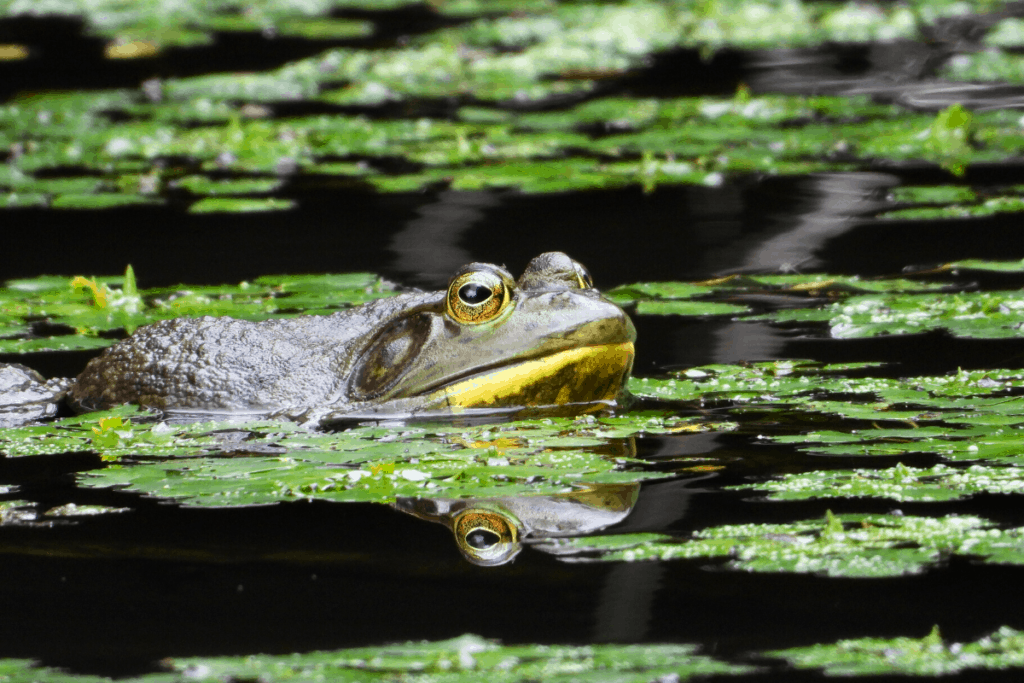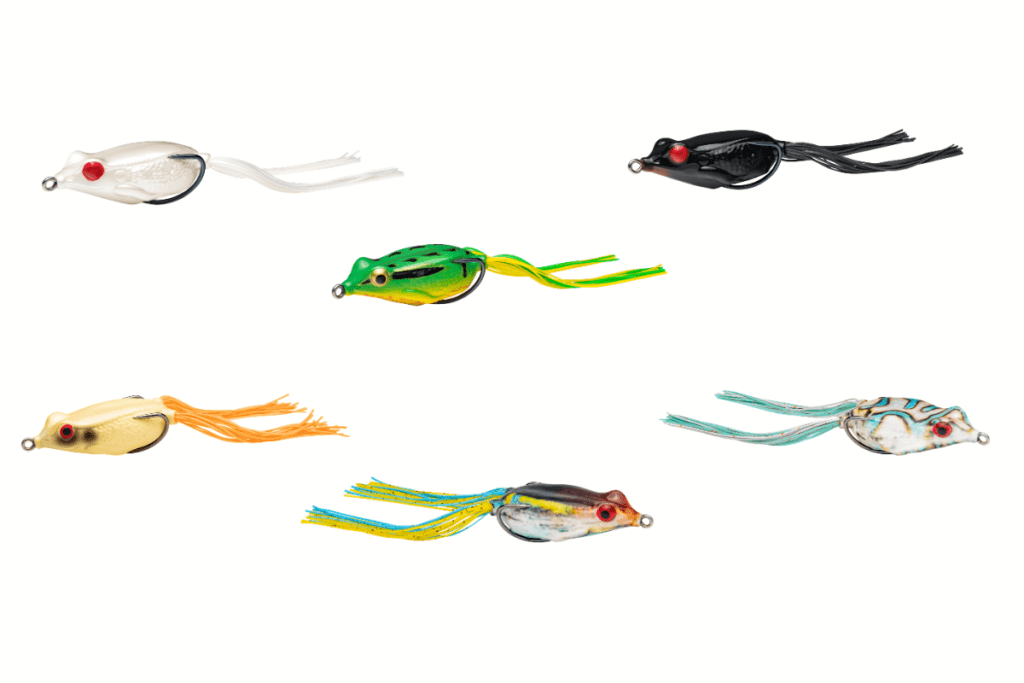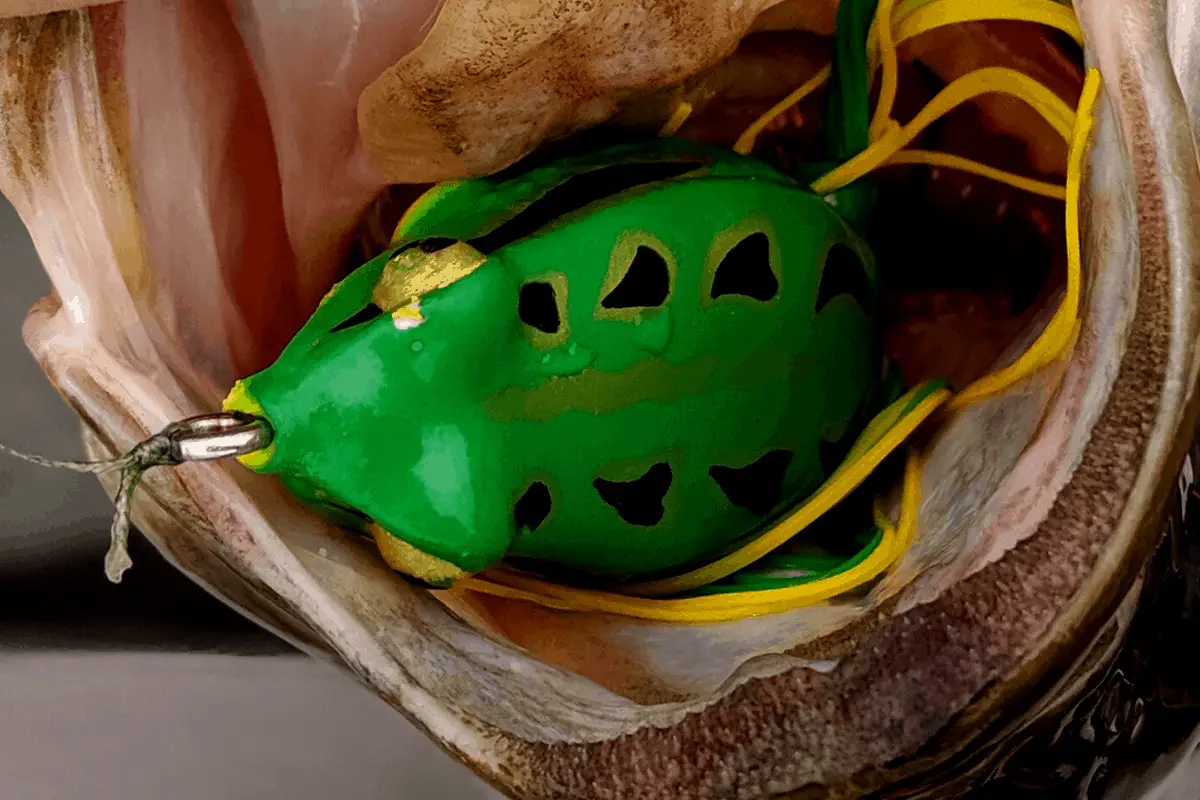Most bass anglers agree topwater fishing is both exciting and addicting. A hollow-body plastic frog may just be the pinnacle of that topwater experience.
Hollow-body plastic frogs can catch bass in many more situations than they often get credit for. Frog fishing is not only perfect for heavy, matted vegetation, but it works equally as well in sparse cover. Using a heavy power rated rod, braided line, and a high-speed reel are the tools used for efficient frog fishing.
Once someone gets hooked on frog fishing, it is hard to put the rod down. In this article, I will discuss the types of cover, presentations, and equipment that will take your frog fishing to the next level.
A Brief History
The hollow-body frog has been around a long time. In fact, you need to go back to 1895 to find the first one. The Hastings company developed, marketed, and sold one to not only catch bass, but pike and muskie as well.
There have been dozens of models, variations, and companies that have followed suit.
No matter who makes them, hollow-body frogs are effective fish catching lures.
Is a Hollow-Body Frog the Perfect Shallow Water Bait?
There is no doubt that a hollow-body frog may just be the perfect shallow water lure. It can go in places where other baits cannot.
Throw a hollow body over limbs? No problem.
Throw it under docks and trees? No problem.
Plop it in the middle of emergent vegetation? No problem.
Bass fishing is all about efficiency. How many casts can you make in a day? How many casts are in the right spot? How many times do you get hung up and have to go retrieve the lure?
A hollow-body frog checks all the boxes because an angler can throw it with confidence into areas and know it will come back to the boat 99% free of entanglements. What other lure can do that?

A Common Misconception
There is no doubt bass eat frogs.
Yet, when we fish the lure that doesn’t necessarily mean that is what the bass thinks it is devouring. This surface lure also does a great job of mimicking baitfish that are hanging near the top of the water column.
Many manufacturers offer plastic frogs in patterns that resemble bluegill and shad.
Thinking of hollow-body frogs as only that, can limit what an angler can do with them and places that they can and should be fished.
Where to Fish a Hollow-Body Frog
Heavy cover? This lure is perfect.
It also works amazingly well around sparse cover. Small patches of weeds, a single stump, a laydown, docks, rock piles, and any other type of bass-holding objects an angler may run across are perfect places to throw this lure.
The frog can be skipped with tremendous effectiveness and put in places where other lures get hung.
It is refreshing to fire a bait into the nastiest of cover and have the confidence that it will come through it effortlessly.
I almost like to think about the lure as a popper that can be fished anywhere. Having that mindset helps us to be more open and objective to places where this lure can be fished with great effectiveness.
The Equipment for Frog Fishing
Traditional frog fishing equipment includes braided line in the 50lbs + range, a heavy power rated rod and a high-speed reel. The rod does not necessarily need a soft tip since the majority of the casts involve distance as opposed to extreme accuracy.
If an angler plans to fish the frog by skipping it under docks and target more isolated pieces of cover, than there are a couple of options.
- A heavy power rated rod with a more moderate tip, or,
- A medium-heavy power rated rod.
Both setups still can use the same line and reel combination.
The heavy power rated rods are best suited to winch bass out of thick cover. If the cover is sparse surrounded by open water, then using a medium-heavy power rating will work fine.

Color Choices
When the water is stained or muddy, choosing frogs with a solid belly color is optimal. Solid white, yellow, and black are all easier to see than broken patterns.
If the water is clear, then choosing some frogs with more natural coloration, like bluegill, is a great choice.
Keep in mind the water clarity and the available forage when deciding what frog pattern to tie on.
The Retrieve
There are a variety of thoughts on the retrieve and cadence of a hollow-body frog.
I tend to believe that we often impart too much action or overwork the frog on many occasions. When thinking about prey species, whether it is a real frog or a bluegill, they often sit still and make small movements more than they dart around erratically.
With that said, there are times when the matted vegetation is thick and the water is so dirty that a more aggressive retrieve may be most effective.
Topwater fishing is an experiment in cadence and pauses until the best one is found. You will know when you have it right because the bass are going to hit the lure better and actual hookups will increase.
If the bass are just swatting at the lure or following it without committing, there is a good chance the cadence and retrieve need to be altered.
Hollow-Body Frog Hooksets are Different
This might be the most frustrating part of fishing a hollow-body frog.
There are days when the bass engulf the bait and seemingly find the end of the hooks on their own. Other days are marked by blowup-after-blowup and no fish to show for it.
As a general guideline, the thicker the cover the more need their is for a slight pause.
I like to wait for two seconds before swinging away and setting the hook. If the bass needs to pull the lure through the cover and reposition it in their mouth, we don’t want to yank the lure away from them too soon.
If you feel pressure before you get to the two count, then go ahead with a solid hookset.
When fishing a frog in more open water or around sparse cover, the waiting is not always needed. The bass can engulf the lure and position it faster than if they have a mouthful of weeds.
It is also important to note that on some days those big largemouth just prefer to explode on the lure several times before finally taking it.
A Shallow Mindset
Depending on the locale, a large percentage of bass will move away from the bank and towards ledges in the summer.
Yet, there will always be some that remain near shallow cover and find shade.
This is especially true in river systems and other bodies of water where the clarity is diminished. Move down the shoreline knowing that there are still good fish to be found shallow. Even on hot days you will find yourself making more accurate casts and using the focus needed to fish that frog efficiently.
Great Lure for New Bass Anglers
It can be challenging to get anglers new to the sport to feel a bass on the end of their line.
Many lures require a certain skill level to present them efficiently. It can also be difficult to master what a bite feels like on a bait like a pitching jig.
A hollow body frog eliminates many of those hurdles new bass anglers must overcome.
Tie one on with braided line and let them toss that lure anywhere they want. They will eventually get a bite and odds are the bass blowing up on that lure will be a good one.
Get a new angler to catch a couple of bass on a frog and I promise you have them dreaming about the next catch.
Final Thoughts
As the summer marches on and shallow cover reaches its thickest, pull out the frog box and get ready for some action.
There is no better lure on the market that can be worked efficiently through all types of shallow water.
Be sure to use a heavy power rated rod when in the thick stuff and a medium-heavy rod will suffice when fishing more sparse cover. Braided line and a high-speed reel will ensure that your presentations can be rapid and placed where the big bass live.
Tight lines. Be safe and make sure to encourage someone today. You never know how you may change their life forever.
Isaiah 6:8

